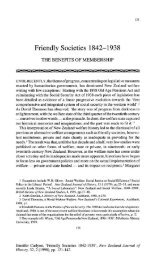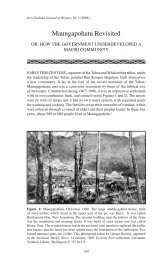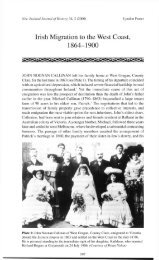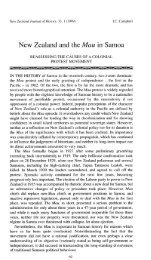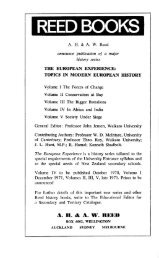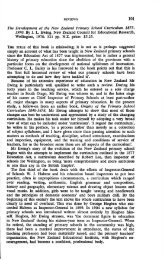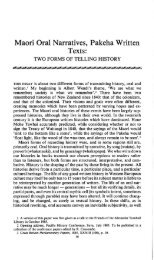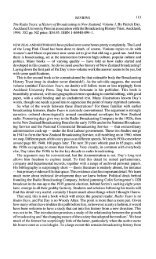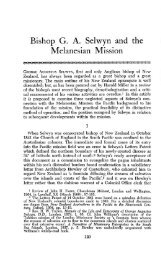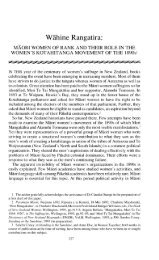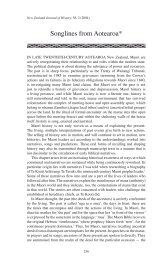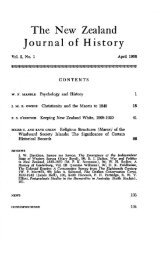John White - New Zealand Journal of History
John White - New Zealand Journal of History
John White - New Zealand Journal of History
You also want an ePaper? Increase the reach of your titles
YUMPU automatically turns print PDFs into web optimized ePapers that Google loves.
50 MICHAEL RE ILLY<br />
until his house was finished, though he promised to write more material at night<br />
once it was completed. 26 In September 1856 he again had no ink to complete their<br />
manuscripts. <strong>White</strong> apparently sought to remedy the lack <strong>of</strong> writing material by<br />
sending some books by ship, and a further supply comprising a manuscript book,<br />
ink and pens a short time later. 27<br />
From the 1870s, and increasingly with his appointment in 1879 to prepare the<br />
Ancient <strong>History</strong> <strong>of</strong> the Maori, <strong>White</strong> initiated a large number <strong>of</strong> requests,<br />
typically instructing his potential informant to 'write as full as you can <strong>of</strong> all the<br />
<strong>History</strong> <strong>of</strong> the Maori, give everything you can no matter how trivial'. 28 If <strong>White</strong><br />
expected armfuls <strong>of</strong> manuscript books to be returned brimming with Maori<br />
history he was soon disappointed. In October 1879 Eru Tahitangata <strong>of</strong> Otaki<br />
informed him that a committee (presumably <strong>of</strong> local Maori elders) would not<br />
agree to sending him any whakapapa or karakia (prayers). Needless to say <strong>White</strong><br />
reacted sharply, commenting on the back <strong>of</strong> Tahitangata's letter: 'if you do not<br />
like to give your Histy, you will be the only tribe not knowfn] to future ages'.<br />
<strong>White</strong> asked for his manuscript volume back so that he could give it to someone<br />
else. 29<br />
More bad news was to follow. In April 1880 a despondent Henare Paraone<br />
from Napier, first sent a book in 1875, wrote that it had been taken away and<br />
hidden by his people while he was collecting more material in Waimarama. He<br />
thought they had hidden the work when they saw what was written inside. 30<br />
<strong>White</strong> also learnt that the book sent in 1876 to Tamati Hapimana <strong>of</strong> Ohiwa in the<br />
Bay <strong>of</strong> Plenty had been accidentally burnt in a house fire. <strong>White</strong> soon sent a<br />
replacement, only to learn from Hapimana that he could not completely fill this<br />
new volume since there were no longer any tohunga. 31 On a more optimistic note,<br />
however, Kawana Hunia (Te Hakeke?) <strong>of</strong> Parewanui (Bulls) in the Rangitikei<br />
confirmed that he had organized six chiefs from Ngati Kahungunu <strong>of</strong> Wairarapa<br />
to write for <strong>White</strong>. The chiefs were Ngario Takatakaputea, Ngatuere, Heremaia<br />
Te Whatu, Tamai Kohia, Wi Waaka and Tikawenga. 32<br />
Maori writers encountered a variety <strong>of</strong> problems themselves, or shared a<br />
reluctance to provide the required information. The Reverend Wiremu Patene<br />
from the Waikato asked <strong>White</strong> to indicate which particular whakapapa and<br />
ancestors he needed information about. 33 Hohaoia Tarakawa <strong>of</strong> Pukerimu seems<br />
26 Taonui to <strong>White</strong>, 19 Aperira (April) 1851, JWMS, A8a, ATL.<br />
27 Taonui to <strong>White</strong>, 8 Hepetema 1856, 26 Oketopa 1856, JWMS, A8a, ATL.<br />
28 Ledger book, JWMS, Alll, ATL. The ledger contained an alphabetically arranged list <strong>of</strong><br />
people to whom requests were sent to write on Maori history between about 1879 and 1885.<br />
29 Tahitangata to <strong>White</strong>, 13 October 1879, NZMS 714, Vol. IV, Auckland Public Library (AP);<br />
<strong>White</strong>'s comment, written on the back <strong>of</strong> the letter, 12 November 1879.<br />
30 Paraone to <strong>White</strong>, 4 Aperira 1880, JWMS, Alia, ATL. Various place-names appear in the<br />
correspondence with Paraone, including Matahiwi and Pa Kowhai, Napier.<br />
31 Ledger book, JWMS, Alll, ATL; Hapimana to <strong>White</strong>, 26 July 1880, NZMS 714, Vol IV, AP.<br />
The place-name in the last letter is Te Awahou. Hapimana's name is written in one place in the<br />
ledger book as Tamati Hapimana Karinga, in another simply as Tamati Hapimana.<br />
32 Ledger book, JWMS, Alll, ATL. A letter from Hunia is signed Kawana Hunia Te Hakeke,<br />
but it is not clear whether Te Hakeke is a personal or place name.<br />
33 Patene to <strong>White</strong>, 18 Maehe (March) 1881, JWMS, A65, ATL. Patene lived either at<br />
Karakiariki, Karokariki, or Karakariki (depending on the spelling).



